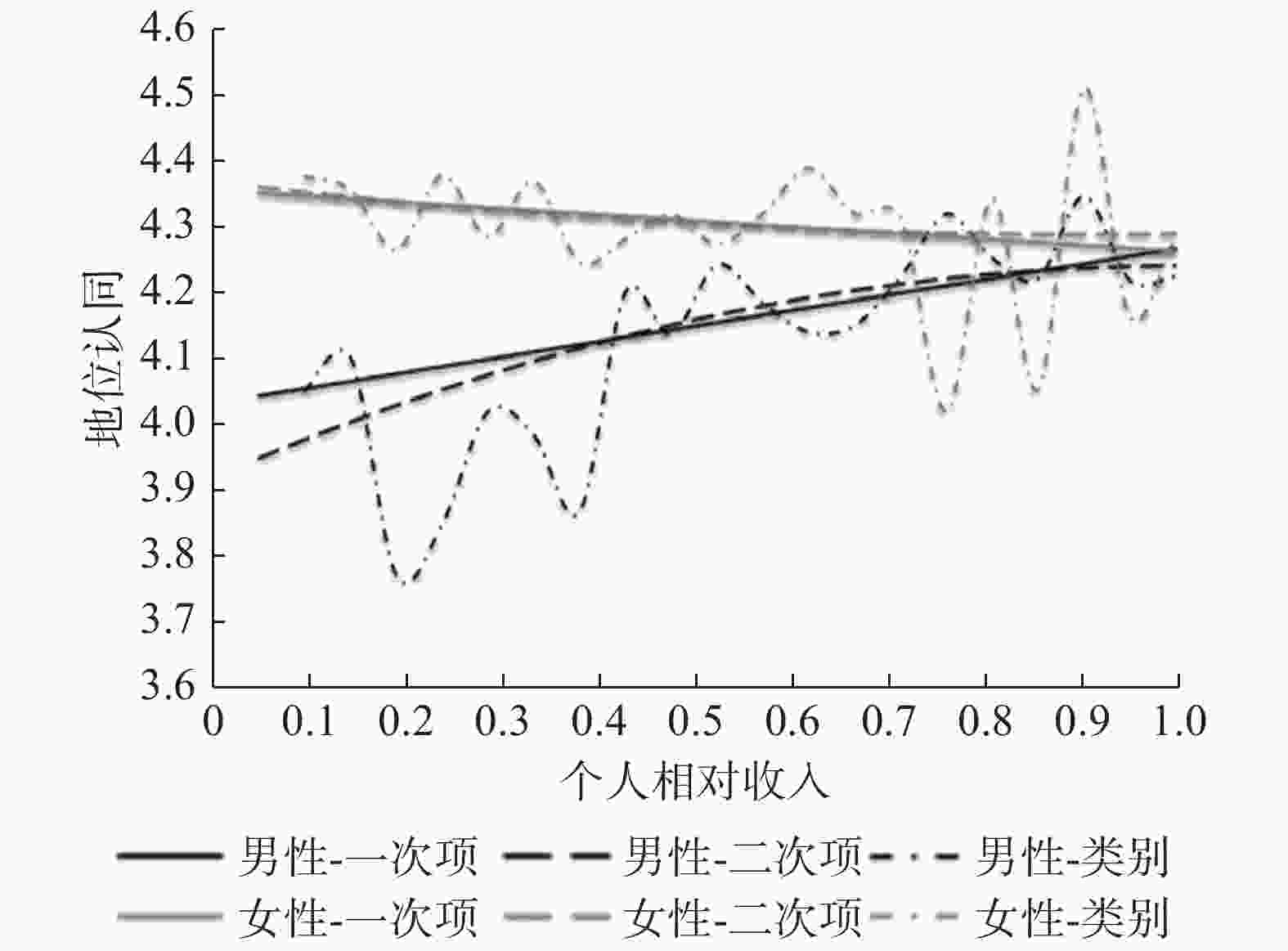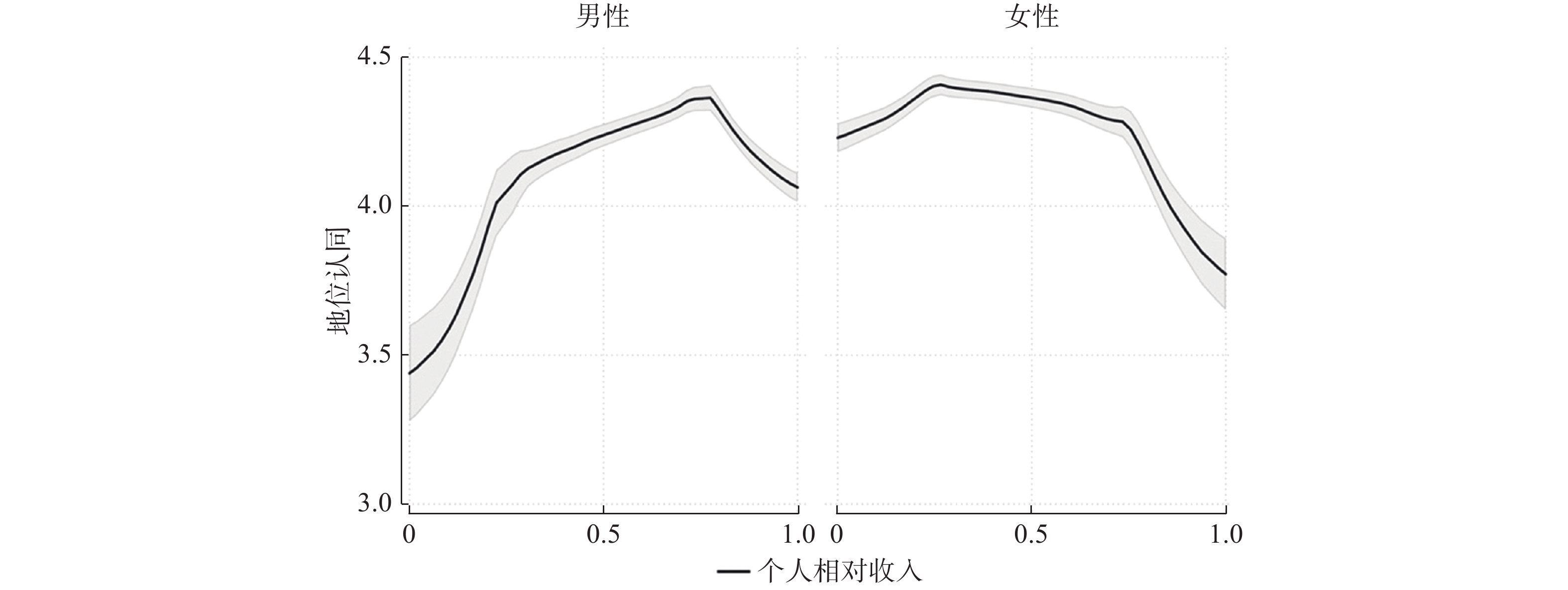相对收入与中国夫妻地位认同—基于“社会比较—性别规范”框架的分析
Relative Income and Class Identification of Chinese Couples
-
摘要: 中国夫妻地位认同仍是以家庭而非个人为基础的,地位决定论强调夫妻任何一方绝对收入的增加都会提升双方的地位认同,然而值得关注的是,夫妻之间的收入比较对双方地位认同的形成究竟会产生什么样的影响。通过构建中国夫妻地位认同的“社会比较—性别规范”分析框架,利用2010—2017年间五轮CGSS数据的分析发现:夫妻之间收入比较与社会性别规范共同形塑了双方的地位认同。相对收入的增加能够显著提升已婚男性的地位认同;同时,受到传统性别规范的制约,收入并不会成为已婚女性与配偶比较的资源,相对收入的变化也不会显著影响其地位认同。“社会比较—性别规范”的理论框架更好地诠释了中国夫妻地位认同的形成机制。Abstract: On the basis that the class identification of Chinese couples is still in the unit of family rather than the individual. While the status determinism thesis emphasizes that an increase in the absolute income of each spouse will enhance both of their class identification, it is still unclear how the relative income between husband and wife affects their respective class identification. This article proposes a theoretical framework of “social comparison-gender norms”. Based on the analysis of five waves of Chinese General Social Survey datasets from 2010 to 2017, this study shows that the relative income between husband and wife and the gender norms together shape the husband and wife’s class identification. Specifically, the increase in relative income only significantly enhances the class identification of married men, but not the married women. Constrained by the traditional gender roles, income is not a kind of resource for comparison between married women and their spouses, and changes in relative income do not significantly affect married women’s class identification. Therefore, the theoretical framework of “social comparison-gender norms” can better explain the formation mechanisms of the class identification among Chinese couples.
-
Key words:
- relative income /
- status identity /
- social comparision /
- gender norms
-
表 1 变量的描述统计 (N = 31732)
变量 男性 (N=15227) 女性 (N = 16505) 均值/百分比 标准差 均值/百分比 标准差 主观地位认同 4.19 1.68 4.31 1.65 个人相对收入 0.68 0.23 0.37 0.24 个人收入 (对数) 9.63 1.76 7.81 3.60 个人受教育年限 9.89 3.83 8.66 4.57 个人年龄 46.59 11.09 44.78 11.30 个人性别观念 0 1 0 1 配偶收入 (对数) 7.30 4.01 9.46 2.01 配偶受教育年限 8.64 4.48 9.72 3.88 14岁时家庭地位评分 2.98 1.77 3.19 1.87 个人政治面貌 非党员 92.94 93.91 党员 17.06 6.09 个人户口 农业户口 55.44 57.83 非农户口 44.56 42.17 个人工作状况 未受雇 17.02 37.31 受雇 82.98 62.69 个人主观流动感知 向下流动 11.32 10.90 未变化 31.93 31.27 向上流动 56.75 57.82 配偶政治面貌 非党员 94.08 84.71 党员 5.92 15.29 配偶户口 农业户口 57.66 55.64 非农户口 42.34 44.36 配偶工作状况 未受雇 40.09 17.51 受雇 59.91 82.49 家庭住房数量 无住房 6.35 6.20 有一套住房 77.01 78.95 有多套住房 16.64 14.85 家庭居住地区 农村 41.01 41.46 城市 58.99 58.54 注:表中报告的结果均经过加权处理。 表 2 个人相对收入对已婚两性地位认同的作用 (N = 31732)
男性 女性 模型1.1 模型1.2 模型1.3 模型2.1 模型2.2 模型2.3 个人收入
(对数)0.116***
(0.009)0.016***
(0.004)配偶收入
(对数)0.021***
(0.004)0.066***
(0.007)个人相对收入 0.208**
(0.064)0.537*
(0.233)−0.083
(0.056)−0.150
(0.140)个人相对收入
平方−0.265
(0.181)0.083
(0.016)夫妻总收入
(对数)0.331***
(0.016)0.326***
(0.016)0.265***
(0.016)0.266***
(0.016)控制变量 控制 控制 控制 控制 控制 控制 截距 −0.655***
(0.131)−2.789***
(0.185)−2.804***
(0.185)0.064
(0.134)−1.737*** (0.180) −1.753***
(0.184)N 15227 15227 15227 16505 16505 16505 R2 0.381 0.392 0.392 0.368 0.377 0.377 注:* p<0.05, ** p<0.01, *** p<0.001;模型中控制变量包括:受访者本人的受教育年限、工作状况、性别观念、年龄、政治面貌、户口、主观流动感知、14岁时家庭地位评分、住房数量、居住地区,配偶的受教育年限、工作状况、政治面貌、户口,以及调查年份。 表 3 稳健性检验
B SE p-value Pseudo R2/R2 N (1) 双职工家庭 男性 0.198 0.097 0.040 0.398 8528 女性 0.035 0.087 0.688 0.374 9427 (2) 青年夫妻 男性 0.193 0.102 0.060 0.461 6808 女性 −0.011 0.085 0.898 0.413 8381 (3) 青年双职工家庭 男性 0.232 0.129 0.073 0.447 4743 女性 −0.043 0.109 0.693 0.400 5859 (4) Logistic 男性 0.486 0.149 0.001 0.199 15227 女性 0.010 0.133 0.943 0.197 16505 (5) LDM 男性 0.355 0.129 0.006 0.193 15227 女性 −0.048 0.109 0.662 0.177 16505 注:* p<0.05, ** p<0.01, *** p<0.001;模型中控制变量与表2中相同。 -



 下载:
下载:





 沪公网安备 31010102003103号
沪公网安备 31010102003103号